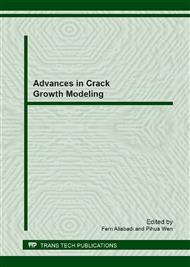[1]
M. H. Aliabadi, Int. J. of Fracture, , Vol. 86 (1997), pp.91-125.
Google Scholar
[2]
A. Portela, M.H. Aliabadi, D.P. Rooke, Computers & Struct., Vol. 46(2) (1993), p.237–247.
Google Scholar
[3]
E. D. Leonel, W. S. Venturini. Engng. Fract. Mech. Vol. 78 (2011), pp.1077-1090.
Google Scholar
[4]
W. K. Liu, S. Hao, T. Belytschko, S. F. Li, C. T Chang. Computational Materials Science, Vol. 16, (1999), pp.197-205.
Google Scholar
[5]
T. Rabczuk, S. Bordas, G. Zi, Computational Mechanics, , Vol. 40(3) (2007),pp.473-495.
Google Scholar
[6]
S. Mohammadi: Extended Finite Element Method for Fracture Analysis of Structures, Blackwell Publishers, UK (2007).
Google Scholar
[7]
N. Sukumar, D. L. Chopp, B. Moran. Engng. Fract. Mech, Vol. 70(1) (2003), pp.29-48.
Google Scholar
[8]
J. R. Shewchuk: Computational Geometry: Theory and Applications, Vol. 22(1-3) (2002), pp.21-74
Google Scholar
[9]
A. George, J. W. H. Liu: Computer solution of large sparse positive definite systems, (Prentice-Hall series in computational mathematics, Prentice-Hall, NJ, USA, 1981)
Google Scholar
[10]
J. R. Rice: J. of Appl. Mech. Vol. 35(1968),pp.379-386
Google Scholar
[11]
W. K. Wilson, I. W. Yu: Int. J. of Fract. Vol. 15(4)(1979), pp.377-387
Google Scholar
[12]
C. H. Wang: Introduction to Fracture Mechanics (DSTO Publishing, Australia, (1996).
Google Scholar
[13]
C. Shih, R. Asaro: Journal of Applied Mechanics Vol. 55(1988), pp.299-316
Google Scholar
[14]
B. Moran, C. F. Shih: Engng. Fract. Mech. Vol. 27(6) (1987),pp.615-642
Google Scholar
[15]
M.A. Hussain, S.L. Pu, J. Underwood: ASTMSTP 560 (1974), pp.2-28
Google Scholar
[16]
X.M. Kong, N. Schluter, W. Dahl: Engng. Fract. Mech. Vol. 52(2) (1995),pp.379-88
Google Scholar
[17]
G.C. Sih: Int. J. Fract. Vol. 10(3) (1974), pp.305-21
Google Scholar
[18]
P.S. Theocaris, N.P. Andrianopoulos: Engng. Fract. Mech. Vol. 16(3) (1982), pp.425-32
Google Scholar
[19]
F. Erdogan, G.C. Sih: J. Basic. Engng. Vol. 85 (1963), pp.519-27
Google Scholar
[20]
H. Hosseini-Toudeshky, B. Mohammadi, H. R. Daghyani: Composite Science and Technology, Vol.66 (2006), pp.188-198
DOI: 10.1016/j.compscitech.2005.04.028
Google Scholar
[21]
R.D. Wang: Engng. Fract. Mech.Vol.56(3) (1997), p.347–356
Google Scholar
[22]
Y. Xiangqiao: Engng. Fract. Mech. Vol.74 (2007),p.2225–2246
Google Scholar
[23]
N. Moes, N. Sukumar, B. Moran, T. Belytschko: An Extended Finite Element Method (X-FEM) for Two- and Three Dimensional Crack Modeling, ECCOMAS, Barcelona (2000).
Google Scholar


